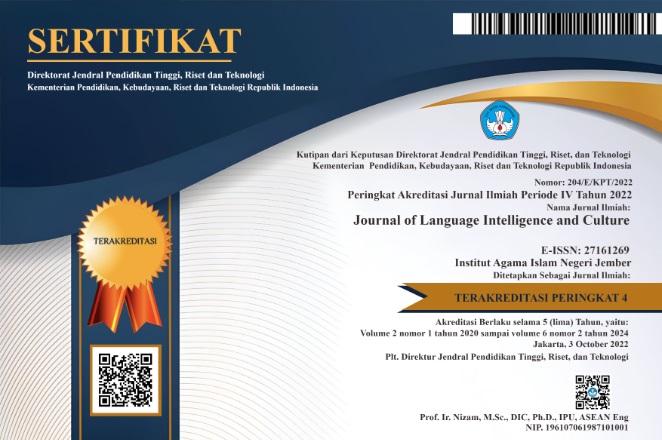Watching English Native Speakers’ Youtube Channel to Improve Students’ Pronunciation Ability
DOI:
https://doi.org/10.35719/jlic.v4i1.77Keywords:
pronunciation, audio-visual media, native speaker, classroom aAbstract
Pronunciation is the way a letter, word, or language is spoken. It involves how a speaker produces sounds, stress, rhythm, and intonation in speech. Some English learners have difficulty with pronunciation since English is considered to be a foreign language in Indonesia. This research aims to show that watching English native speakers’ YouTube channel can improve students’ pronunciation ability. The researcher applied Classroom Action Research and it needed two cycles (four meetings). The criteria of success were that the students achieve the minimum standard or average score, which was equal to or greater than 70%. The students’ pretest score was 35% (very poor) and the result of the interview with the English teacher suggested that the students could not pronounce accurately since they rarely practice and never learn from native speakers. The first posttest score was 57,5% (very poor). The second posttest score was 87% (very good). It showed that the students’ score was increase and achieve the minimum standard. It could be concluded that watching English native speakers’ YouTube channel is an effective way to improve the students’ pronunciation ability.
References
Arikunto, S. (2010). Penelitian Tindakan. Yogyakarta: Aditya Media.
Bull, V. (2015). Oxford Learner’s Pocket Dictionary Fourth Edition. New York: Oxford University Press.
Çakir, I. (2006). The Use of Video as An Audio-Visual Material in Foreign Language Teaching Classroom. The Turkish Online Journal of Educational Technology (TOJET). Vol. 5 Issue 4 Article 9.
Cambridge Dictionary (Online). Accessed April 15, 2021. https://dictionary.cambridge.org/ dictionary/english/vlog
Gilakjani, A. P. (2016). English Pronunciation Instruction: A Literature Review. International Journal of Research in English Education.
Hikmah, D. (2019). Media For Language Teaching and Learning in Digital Era. IJOEEL 01, no. 02 (December 2019): 36-41.
Hopkins, D. (2011). A research to Classroom Research. Yogyakarta: Pustaka Pelajar.
Kelly, G. (2001). How to Teach Pronunciation. England : Longman.
Ma’lah, L. (2016). Pronunciation Problems: A study of Indonesian EFL Students at State Junior High School 2 Kaligondang in The Academic Year of 2015/2016. Purokerto: University of Muhammadiyah Purokerto.
Muhsin, M. (2018). The Use of Video Blogging as Media to Improve Students’ Speaking Skills. Salatiga: State Institute for Islamic Studies of Salatiga.
Perwira, Y. K. (2011). Students’ pronunciation Ability in Reading Report Text. Semarang: Semarang State University.
Putra, F. S. (2019). Applying Small Group Discussion Technique to Improve the Students’ Writing Descriptive Text Skill at The Tenth Grades of SMK Wahid Hasyim Ma’arif NU 05 Pekalongan Lampung Timur. Lampung: State Islamic Institute Metro.
Sari, Y. N. (2019). YouTube as a Learning Media to Improve the Student’s Speaking Ability in 21st Century. JELTL (Journal of English Language Teaching and Linguistics) 4, no. 2 (2019), 263-273.
Sekretariat Negara RI, Peraturan Pemerintah Republik Indonesia Nomor 32 Tahun 2013 tentang Perubahan atas Peraturan Pemerintah Tahun 2005 tentang Standar Nasional Pendidikan.
Yoshida, M. T. (2018). Choosing Technology Tools to Meet Pronunciation Teaching and Learning Goals. The Catesol Journal. Irvine: University of California Press.
Downloads
Published
How to Cite
Issue
Section
License
Copyright (c) 2022 Maufiratul Hasanah, Suparwoto Sapto Wahono, Suparwoto Sapto Wahono

This work is licensed under a Creative Commons Attribution-ShareAlike 4.0 International License.













